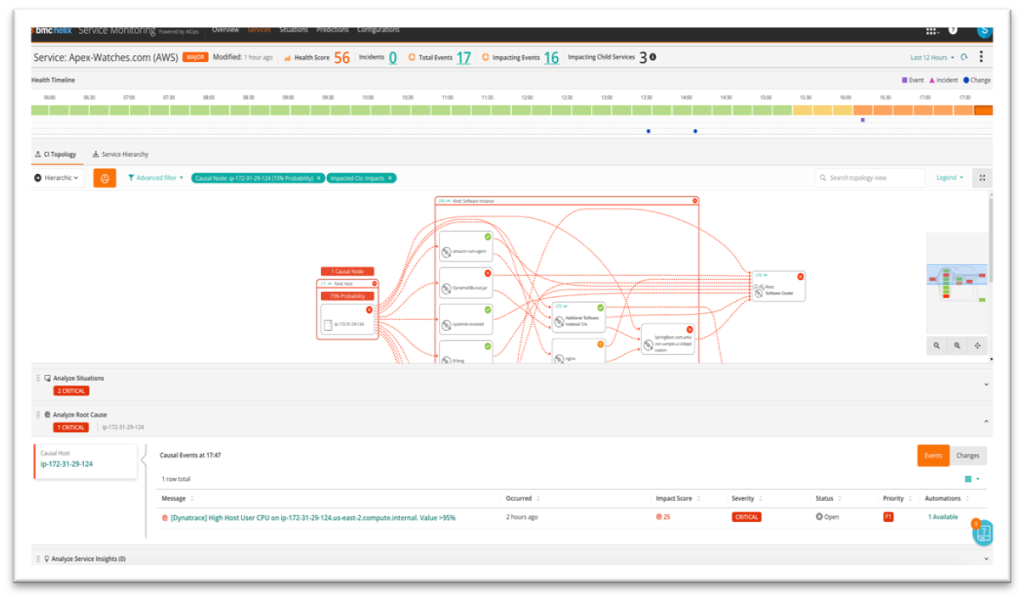“What is the impact of this change?” That’s a very hard question to answer in today’s complex digital environments, particularly as cloud and DevOps adoption increases the speed of change. As applications and the supporting infrastructure grow and evolve continuously, how quickly IT operations (ITOps) teams can answer that question will determine how quickly they can diagnose and remediate the problem. Let’s take a step back and explore why it’s important to stay on top of change.
Change is the leading cause of production issues
Whatever the observed behavior—a service performance degrades, a service becomes unavailable, resource contention issues—issues can eventually be traced to a change or changes in the system. It might be a system change such as turning on and off feature flags, a configuration change, a system upgrade push, or an autoscaling action. It could also be a workload change related to a business running a site-wide sales event. How well your digital service performs is related to changes in your code, infrastructure, workload, and network.
In DevOps environments, these changes happen multiple times a day, and for good reason. We must continuously improve our application functionality and performance to meet customer expectations. Unfortunately, new changes also bring new risks. Maintaining application delivery speed and quality among the complexities of modern IT environments can be an overwhelming challenge.
How ServiceOps helps to manage the pace of change
To balance the pace of change and risk, IT organizations need a new approach that bridges the gap between service management and operations practices. This is where ServiceOps comes in, breaking down barriers to accelerate change while predicting and managing risk. Through change impact analysis, service automation, observability, and AIOps, IT teams are empowered to reduce service outages caused by change.
BMC Helix ServiceOps combines the configuration management and change management capabilities of BMC Helix ITSM and third-party applications with the BMC Helix observability and AIOps solution to give IT teams more confidence in delivering resilience to the business.
Proactive change impact management
The most effective practice to manage change and its impacts among the chaos of ever-evolving technologies is proactively analyzing risk to avoid making changes that will likely cause an incident. With BMC Helix ITSM’s change management capabilities, service management teams can create change requests, run impact analysis, and schedule change dates through a graphical calendar to reduce conflicts. Based on the discovery and modeling that’s already been done for the service by BMC Helix Discovery, service managers can see how the applications relate and talk to each other.
When the service management team creates a change request for an application, they can run an impact analysis by simply pushing a button in BMC Helix ITSM. Through the change analysis, service management teams will be able to understand, in their change windows, what’s being changed, what’s going to get impacted, and if there are any collisions that need to be scheduled to avoid issues being changed at the same time. Addressing potential collisions leads to reduced incidents, reduced risk of a failed change, and increased stability in the environment. For example, if you’re making an application change and there’s an infrastructure change happening at the same time, the change manager can avoid collision issues by adjusting the timing of those changes so they do not overlap.

Figure 1: BMC Helix ITSM change impact analysis
Continuous monitoring and improvement
Monitoring the impact of changes before and after is critical to spotting imminent change-related incidents before they occur. BMC Helix Discovery helps by automatically discovering and tracking relationships between the configuration items (CIs), and visually presenting the topology maps so service management teams can feel more confident about the changes that they make. More importantly, this information can be shared with the development and infrastructure teams so they can see the potential impact their changes will have on the environment.
When the changes are implemented in production, service and operations teams can continue to monitor the impact using the service health timeline from the BMC Helix observability and AIOps solution, which also helps them quickly understand whether an incident might have been caused by recent changes to the environment, saving them the time and energy of blindly sifting through log files.

Figure 2: BMC Helix observability and AIOps showing the service health timeline
Documenting, tracking, reporting, and auditing all the information on a change helps to prevent unauthorized changes and meet service level agreements (SLAs). Service management teams can use out-of-the-box BMC Helix ITSM change management reports and dashboards to understand and monitor change activity within the organization. Reports listing details of changes like change type, urgency, status, incidents caused by changes, and upcoming changes provide visibility into changes and their impact on business SLAs.
Correlation of incidents to changes
When an incident emerges from a change, service operators or site reliability engineers (SREs) need a way to correlate it to the change. The BMC Helix observability and AIOps solution presents a view of the specific incident that contains all the data necessary to diagnose the issue. Clear visualizations of the service model and topology, and other rich information related to the incident such as the service health timeline, help to correlate the incident to the changes that caused them.

Figure 3: BMC Helix observability and AIOps showing the service health timeline, service topology, and root cause analysis
Using AI to correlate the events, changes, incidents, and service topology, BMC Helix observability and AIOps visually presents the relationship between a service and its nodes with node details such as events, incidents, and changes in a unified view. The contextual topology map also presents the complete picture of all CI elements, starting with the infrastructure nodes, network devices, hosts, clusters, namespaces, and all the application nodes of a service. In addition to the CI topology map, the solution provides a service hierarchy to help operators investigate the impacted service and/or child services easier. For example, when looking at the impact of storage or something in the infrastructure going down, service management teams could identify the shared services or infrastructure and see what may be related and impacted when determining the scope.
Using the BMC Helix Integration Service, the BMC Helix platform aggregates change data from all change feeds and tools, including change management, configuration management, Azure DevOps, and Jira. The BMC Helix observability and AIOps solution then applies causal AI to identify the root cause of issues and the changes that likely caused them.
With this information in a unified view, the ITOps, network operations center (NOC), DevOps, and SRE teams can identify the impacted nodes and impact path and work on a resolution immediately.
Get started with BMC ServiceOps today
Change impact analysis, observability, and AIOps play key roles in proactively managing risk and reducing outages caused by change. Using AI and automation in change management leads to change processes that are more predictive and efficient and less prone to human error. BMC Helix ServiceOps leverages the key capabilities of BMC Helix IT service management and IT operations to help both teams answer the question: “What is the impact of this change?”
BMC Helix ServiceOps strives to make IT service management and operations more efficient and more collaborative. When done right, ServiceOps will empower IT organizations to proactively manage risk and solve problems quickly with minimal impact on critical business services.
To learn more about how BMC Helix ServiceOps can transform your service and operations, schedule a customized demo today.
These postings are my own and do not necessarily represent BMC's position, strategies, or opinion.
See an error or have a suggestion? Please let us know by emailing blogs@bmc.com.






